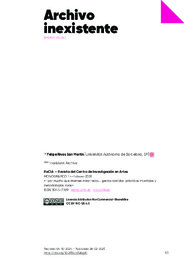Por favor, use este identificador para citar o enlazar este ítem:
https://hdl.handle.net/11000/36538Registro completo de metadatos
| Campo DC | Valor | Lengua/Idioma |
|---|---|---|
| dc.contributor.author | Rivas San Martín, Felipe | - |
| dc.contributor.other | Departamentos de la UMH::Arte | es_ES |
| dc.date.accessioned | 2025-04-30T11:31:19Z | - |
| dc.date.available | 2025-04-30T11:31:19Z | - |
| dc.date.created | 2025-02-28 | - |
| dc.identifier.citation | ReCIA — Revista Del Centro De Investigación En Artes, 1, 153-171 Núm. 1 (2025): «—por mucho que intentes mirar recto… GESTOS TORCIDOS, PRÁCTICAS INVERTIDAS Y METODOLOGÍAS RARAS.» | es_ES |
| dc.identifier.issn | 3045-7769 | - |
| dc.identifier.uri | https://hdl.handle.net/11000/36538 | - |
| dc.description.abstract | Un archivo inexistenteesunaserie de fotografías ficticias de parejas homosexuales ypersonas queer o no binarias, de clase trabajadora y situadas a principios del siglo XX en América Latina.Las imágenes fueron creadas coninteligencia artificialgenerativa, por lo que no corresponden a personas reales. Se trata de un ejercicio retrofuturista que utiliza algoritmos computacionales —tecnología habitualmente inmersa en narraciones de futuro—para reimaginar nuestro pasado queer/kuir local yreivindicar un archivo que ni siquiera pudo existir.Y es que, como explicó el crítico cubano-norteamericano José Esteban Muñoz, una de las consecuencias de la cultura heteronormativa es que la experiencia queerdel pasado casi no pudo dejar registro ni archivo. Estanegación del archivoes todavía más dramática para las personas del sur global y de clases trabajadoras.Inicialmente, el texto aborda algunos antecedentes de obras que experimentaron con IA generativa tituladas Imaginación artificial. Adicionalmente, el artículo señala algunas consideraciones y consecuencias “tecno-poéticas” del trabajo con modelos de IA. Por ejemplo, las que derivan del uso del proceso de “difusión” inverso, que podría describirse como un engaño al modelo, que le obliga a retornar a una hipotética imagen previa que nunca existió. O la necesidad de contrarrestar los sesgos de clase y raza presentes en las bases de datos con las que se entrenaron los modelos, obstáculo del cual emergió el concepto de prompt minoritario. Por último, el artículo también explica la decisión de mantener los errores en la representación corporal que son propios de estas técnicas. Esos errores se integran al proyecto como una capa adicional de disidencia corporal y como un límite ético-político que evidencia su origen artificioso, para evitar que estas imágenes pudiesen llegar a encubrir el pasado de violencias que impidió su propia existencia | es_ES |
| dc.description.abstract | An inexistent archiveis a series of fictional photographs of gay couples and queer or non-binary, working-class people set in early 20th century Latin America. The images were created with generative artificial intelligence, so they do not correspond to real people. It is a retro-futuristic exercise that uses computational algorithms -technology usually immersed in futuristic narratives-to reimagine our local queer/kuirpast and reclaim an archive that could not even exist. As Cuban-American critic José Esteban Muñoz explained, one of the consequences of heteronormative culture is that the queer experience of the past could leave almost no record or archive. This denial of the archive is even more dramatic for people from the global south and the working classes. Initially, the text discusses some background of works that experimented with generative AI entitled Artificial Imagination. Additionally, the article points to some “techno-poetic” considerations and consequences of working with AI models. For example, those deriving from the use of the reverse “diffusion” process, which could be described as cheating the model, forcing it to return to a hypothetical prior image that never existed. Or the need to counteract the class and race biases present in the databases on which the models were trained, an obstacle from which the concept of “minority prompt” emerged. Finally, the article also explains the decision to maintain the errors in body representation that are inherent to these techniques. These errors are integrated into the project as an additional layer of bodily dissidence and as an ethical-political limit that evidences their contrived | es_ES |
| dc.format | application/pdf | es_ES |
| dc.format.extent | 19 | es_ES |
| dc.language.iso | spa | es_ES |
| dc.publisher | Centro de Investigación en Artes de Altea Universidad Miguel Hérnández | es_ES |
| dc.rights | info:eu-repo/semantics/openAccess | es_ES |
| dc.rights | Attribution-NonCommercial-NoDerivatives 4.0 Internacional | * |
| dc.rights.uri | http://creativecommons.org/licenses/by-nc-nd/4.0/ | * |
| dc.subject | Inteligencia artificial | es_ES |
| dc.subject | archivo queer | es_ES |
| dc.subject | imagen técnica | es_ES |
| dc.subject | arte generativo | es_ES |
| dc.subject | retrofuturismo | es_ES |
| dc.subject | arte queer | es_ES |
| dc.subject | latinoamericano | es_ES |
| dc.subject | prompt | es_ES |
| dc.subject.other | CDU::7 - Bellas artes | es_ES |
| dc.title | Archivo inexistente | es_ES |
| dc.type | info:eu-repo/semantics/article | es_ES |
| dc.relation.publisherversion | https://doi.org/10.21134/a3y8jg10 | es_ES |

Ver/Abrir:
ReCIA_1_EV+2_Felipe+Rivas_Archivo+Inexitente.pdf
Investigación artística
16,48 MB
Adobe PDF
Compartir:
 La licencia se describe como: Atribución-NonComercial-NoDerivada 4.0 Internacional.
La licencia se describe como: Atribución-NonComercial-NoDerivada 4.0 Internacional.
.png)